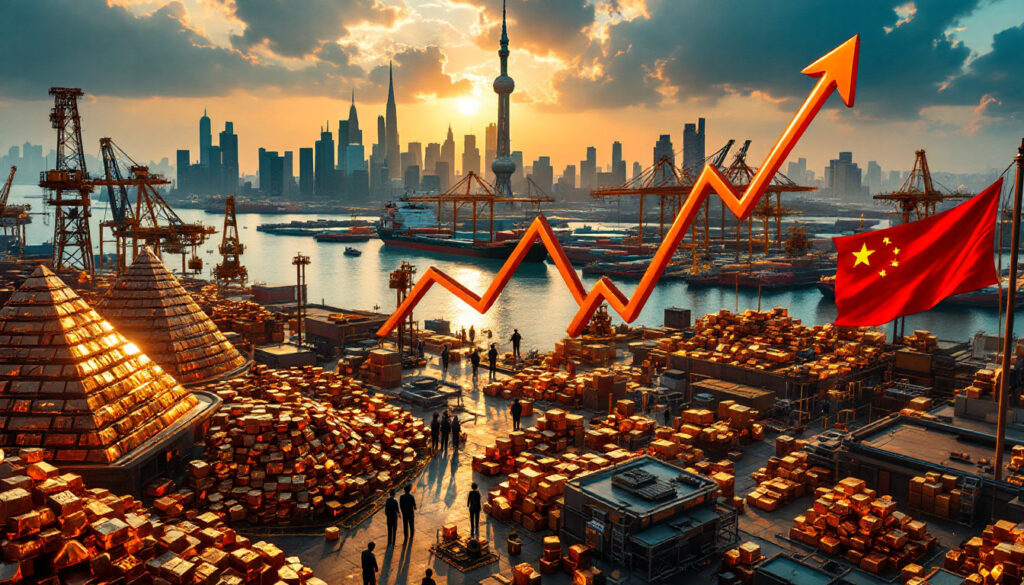Understanding China's Copper Market Dynamics: Demand, Premiums, and Global Impact
China's dominance in the global copper market 2025 continues to shape worldwide trading patterns, price movements, and supply chain strategies. As the world's largest consumer of copper, accounting for more than 50% of global demand, China's purchasing behavior creates ripple effects felt across international markets. Recent shifts in buying patterns and premium structures signal important changes that investors, traders, and industry participants need to understand.
What is the Yangshan Premium and Why Does It Matter?
The Yangshan premium represents the additional cost above London Metal Exchange (LME) prices that buyers in China pay to import physical copper. Named after the Yangshan free trade zone in Shanghai where large volumes of copper are delivered, this premium serves as a critical market indicator.
Unlike futures contracts which reflect expectations, the Yangshan premium directly measures current physical market conditions. It represents the actual premium Chinese buyers are willing to pay above the global benchmark price to secure immediate physical delivery of copper cathodes.
How the Yangshan Premium Indicates Market Strength
This premium functions as a real-time barometer of China's copper market health. When domestic supplies tighten or demand increases, the premium rises as buyers compete for available imports. Conversely, when the Chinese market is well-supplied or demand weakens, the premium contracts.
Market analysts closely monitor these premium movements to gauge underlying physical market conditions. A rising premium typically indicates stronger-than-expected consumption or supply constraints within China, while a falling premium suggests weakening demand or abundant domestic supply.
Recent Premium Surge Signals Market Transformation
The Yangshan copper premium has experienced a dramatic resurgence in recent months, climbing from just $35 per metric ton in February 2025 to $94 per ton by late April 2025 – reaching its highest level since November 2023. This 168% increase over a mere two-month period reflects a fundamental shift in market conditions.
Shanghai Metals Market (SMM) data confirms this significant uptrend represents more than temporary volatility. The premium now stands at its highest point in 16 months, signaling renewed buying interest from Chinese importers after a prolonged period of subdued activity.
Why is Chinese Copper Demand Surging Now?
Multiple factors have converged to drive China's renewed appetite for copper imports, creating a complex market dynamic that extends beyond typical seasonal patterns.
Domestic Consumption Patterns Driving Inventory Reductions
A significant depletion of copper inventories across Chinese warehouses has occurred in recent weeks. Shanghai Futures Exchange (SHFE) warehouse stocks have fallen by approximately 12% since mid-March 2025, dropping from 235,317 tons to around 207,000 tons.
This accelerated destocking has maintained upward pressure on spot premiums. According to analysis from ANZ Group Holdings Ltd., "The unexpectedly robust domestic demand has drawn down inventories faster than anticipated, particularly in the Shanghai region, forcing buyers to pay higher premiums for imported material."
The grid infrastructure sector has been particularly active, with China's State Grid Corporation accelerating deployment of ultra-high voltage transmission projects that consume substantial copper volumes. Each kilometer of UHV line requires between 40-60 tons of copper, and the current five-year plan includes over 6,000 kilometers of new lines.
Trade Tensions Creating Market Distortions
The copper market is experiencing disruption from potential copper-specific tariffs, particularly following Trump's trade impact on metal markets. These trade tensions have encouraged preemptive metal flows toward the United States, with traders repositioning material in anticipation of policy changes.
This redirection of supply has created tightness in other markets, intensifying competition for available copper globally. Chinese buyers have responded by offering higher premiums to ensure supply continuity, further supporting the Yangshan premium's upward trend.
Market Insight: "We're seeing a bifurcation in global copper flows, with material being preemptively diverted to U.S. warehouses ahead of potential tariff implementation, creating artificial tightness in Asian markets," noted a senior metals strategist at a major trading house. "This explains part of the premium surge in China, as normal supply channels become disrupted."
How Are Global Copper Prices Responding?
The recent movements in physical premiums have coincided with significant volatility in global copper futures markets, creating complex trading conditions.
LME Price Recovery Following Market Turbulence
London Metal Exchange (LME) copper prices have rebounded significantly since their collapse during the broader market volatility that followed the U.S. tariff announcements. After reaching one-year lows of approximately $8,600 per ton in early March 2025, prices have recovered substantially.
Chinese buying interest has played a pivotal role in this resurgence. The combination of rising physical premiums and futures price increases suggests fundamental support for copper rather than merely speculative activity.
Current Price Movements and Market Sentiment
As of late April 2025, LME copper was trading at $9,459.50 per ton, representing a 0.9% daily increase and approximately 10% above the March lows. This upward movement reflects improving market sentiment and growing confidence in demand fundamentals.
Other base metals have followed similar patterns, with aluminum rising 1.3% to $2,464.50 and zinc gaining 1.1%, indicating broader positive sentiment across industrial metals. The relatively stronger performance of copper suggests specific supply-demand dynamics supporting the red metal beyond general market trends.
What's Behind China's Strategic Copper Buying?
China's aggressive copper purchasing behavior extends beyond immediate industrial needs, reflecting broader strategic considerations that influence market behavior.
Supply Security Concerns Amid Geopolitical Uncertainty
China's recent copper buying reflects strategic concerns about future supply security. With global trade relationships becoming increasingly complicated by geopolitical tensions, ensuring consistent access to critical industrial metals has become a national priority.
The country's manufacturing sector relies heavily on copper for everything from electronics to infrastructure. Electric vehicle production, which requires approximately 83kg of copper per vehicle (compared to about 23kg for conventional vehicles), has become particularly important in China's industrial strategy.
Additionally, the country's focus on renewable energy development—including solar, wind, and associated grid infrastructure—creates substantial copper demand. Each megawatt of solar capacity requires approximately 5 tons of copper, while offshore wind installations need up to 15 tons per megawatt.
Processing Capacity Dominance Reinforces Market Position
China maintains a commanding position in global copper processing, controlling over 50% of the world's refining capacity. This downstream dominance gives China significant influence over the entire copper value chain.
The country has systematically expanded its smelting capacity, growing from approximately 5 million tons annually in 2010 to over 12 million tons in 2024. This expansion has outpaced domestic mine production, creating structural dependence on imported copper concentrates and scrap.
By maintaining robust import volumes even during periods of economic uncertainty, China effectively supports global copper prices while ensuring its processing facilities operate at optimal capacity—a strategy that maximizes its influence within the global copper ecosystem.
How Do Chinese Copper Imports Affect Global Supply Chains?
China's position as the dominant copper consumer creates profound impacts throughout global supply chains, affecting everything from mining investment decisions to international shipping patterns.
Regional Market Imbalances Created by Chinese Demand
The surge in Chinese copper buying has created regional supply imbalances, with material being diverted from other markets to satisfy this demand. European fabricators have reported increasing difficulty securing prompt deliveries, with regional premiums rising sharply in response.
This reallocation affects pricing and availability across Asia, Europe, and the Americas. Japanese buyers, traditionally important players in the Asian copper market, have found themselves competing more intensely with Chinese counterparts, pushing Japan's import premiums to $85 per ton, their highest level since August 2023.
Price Premium Variations Across Different Markets
While the Yangshan premium reflects conditions in China, similar premiums exist in other regions, though often at different levels. European Grade A cathode premiums currently stand at approximately €150 per ton ($162), while U.S. Midwest premiums have reached 8.2 cents per pound ($180 per ton).
These variations create arbitrage opportunities for traders but also signal the uneven distribution of copper availability worldwide. The differential between Asian and Western premiums has narrowed considerably in recent months, suggesting a more balanced global market despite China's increased buying activity.
What Are the Long-Term Implications for Copper Markets?
The current dynamics in China's copper market may have lasting effects on global copper trade, investment patterns, and price structures.
Structural Changes in Global Copper Trade Flows
The current market dynamics signal potential longer-term structural changes in global copper movements. Traditional trading patterns established over decades are being reconsidered as countries increasingly prioritize resource security over pure economic efficiency.
Chinese companies have accelerated overseas mining investments, particularly in Africa's Copper Belt and South America, to secure long-term supply. These investments often include offtake agreements that direct copper production to China regardless of prevailing market conditions, potentially reducing available supply for other consumers.
Investment Implications for Mining Companies and Processors
For copper producers and processors, China's sustained demand presents both opportunities and challenges. While strong premiums support profitable exports to China, companies must also navigate the complexities of shifting trade policies.
Mining companies are adjusting development timelines to align with projected Chinese demand patterns. Several major miners, including companies focused on Rio Tinto's copper investment, have recently announced accelerated development schedules for copper projects, citing stronger-than-expected Chinese consumption as a key factor.
Industry Perspective: "The premium environment we're seeing in China validates our decision to prioritize copper within our portfolio," stated the CEO of a major diversified mining company. "The combination of energy transition demand and China's continued industrialization creates a compelling long-term case for copper development despite short-term price volatility."
How Does China's Copper Demand Compare Historically?
Placing current market conditions within historical context provides valuable perspective on potential future developments.
Cyclical Patterns in Premium Fluctuations
The Yangshan premium has historically followed cyclical patterns, with previous peaks often preceding periods of strong economic activity in China. Notable premium surges occurred in 2017 (reaching $135/ton) and late 2021 (peaking at $105/ton), both coinciding with periods of robust industrial production growth.
The current 16-month high represents a significant deviation from the more subdued premium environment that characterized much of 2023 and early 2024, when premiums averaged closer to $30-40 per ton amid economic uncertainty in China.
Correlation With Economic Indicators and Policy Shifts
Chinese copper demand typically correlates with broader economic indicators. The recent premium increases suggest potential improvement in key sectors, possibly supported by government stimulus measures.
Historical analysis shows the Yangshan premium tends to lead official economic data by approximately 2-3 months, making it a valuable forward indicator of China's industrial activity. The current premium strength suggests improving conditions in manufacturing and construction sectors that may not yet be fully reflected in official statistics.
FAQ: China's Copper Market
What factors most influence the Yangshan copper premium?
The premium is primarily affected by:
- Domestic supply-demand balance within China
- Import policies and customs clearance efficiency
- Arbitrage opportunities between Shanghai Futures Exchange and LME prices
- Financing availability for metal imports
- Logistical constraints affecting deliveries to China
- Seasonal consumption patterns
- Strategic purchasing by state-affiliated entities
How does seasonal demand affect China's copper market?
China typically experiences stronger copper demand in the second and third quarters when construction and manufacturing activity accelerates. This seasonality often creates a pattern where:
- Q1: Relatively weak demand during Lunar New Year period
- Q2: Strengthening consumption as construction season begins
- Q3: Peak demand period for manufacturing and grid infrastructure
- Q4: Gradual moderation as winter construction slowdown begins
This pattern influences premium movements, with higher premiums typically occurring during peak consumption periods.
What role do China's strategic reserves play in copper market dynamics?
The State Reserve Bureau (SRB) manages China's strategic metal stockpiles and occasionally conducts significant market operations that impact prices and premiums:
- Strategic Purchases: During periods of low prices, the SRB may build reserves, creating additional demand that supports prices and premiums
- Strategic Sales: When prices reach excessive levels, the SRB may release material to moderate market overheating
- Market Signaling: Even announcements about potential SRB activity can influence market sentiment
These activities are rarely announced publicly in advance, creating periodic market surprises when large transactions are detected.
How might future trade policies affect China's copper imports?
Potential changes in tariff structures could substantially alter copper trade flows:
- Increased tariffs on Chinese goods may reduce manufacturing exports and associated copper demand
- Retaliatory measures could affect copper concentrate imports from major suppliers
- Shifts in scrap metal regulations continually reshape recycling flows
- Environmental policies increasingly influence smelter operations and import permissions
The complex interplay of these factors creates an environment where policy changes can rapidly alter premium structures and regional price differentials.
Market Outlook: The China and copper market will likely continue experiencing above-average volatility through 2025 as China's demand patterns evolve and global trade relationships adjust to changing political realities. While short-term price movements may remain erratic, the fundamental supply-demand outlook supports a robust long-term price environment, with Chile copper production trends and Chile copper export recovery playing crucial roles alongside China's continuing decisive role in global copper market direction.
Ready to Profit from the Next Major Copper Discovery?
Discovery Alert's proprietary Discovery IQ model instantly identifies significant ASX copper discoveries, transforming complex geological data into actionable investment opportunities before the broader market reacts. Explore how historic mineral discoveries have generated substantial returns by visiting Discovery Alert's dedicated discoveries page and position yourself ahead of the market.




